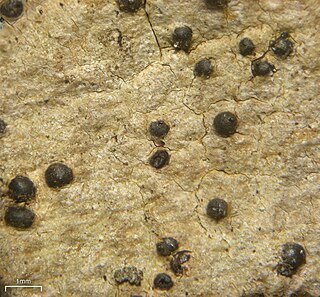
Eurotiomycetes is a large class of ascomycetes with cleistothecial ascocarps within the subphylum Pezizomycotina, currently containing around 3810 species according to the Catalogue of Life. It is the third largest lichenized class, with more than 1200 lichen species that are mostly bitunicate in the formation of asci. It contains most of the fungi previously known morphologically as "Plectomycetes".

The Gomphales are an order of basidiomycete fungi. Some or all families belonging to Gomphales have been sometimes included in the order Phallales, the now-obsolete Ramariaceae was also previously included in Cantharellales. Recent phylogenetic analyses include in Gomphales the families of the original description of the order by Walter Jülich, with addition of Clavariadelphaceae. According to one 2008 estimate, the Gomphales contain 18 genera and 336 species.
Biatorellaceae is a family of lichen-forming fungi in the subclass Lecanoromycetidae. The family is monotypic, and contains the single genus Biatorella, which contains eight species.

The Pyrenulales are an order of ascomycetous fungi within the class Eurotiomycetes and within the subphylum Pezizomycotina.
Sulcopyrenula is a genus of lichen-forming fungi in the family Pyrenulaceae. It contains five species. The genus was circumscribed by Hiroshi Harada in 1999, with Sulcopyrenula staurospora assigned as the type species. It is distinguished from other genera in the Pyrenulaceae by its longitudinally grooved ascospores.
Pyrgillus is a genus of lichen-forming fungi in the family Pyrenulaceae. The genus was circumscribed by the Finnish lichenologist William Nylander in 1858.
Mazaediothecium is a genus of calicioid lichens in the family Pyrenulaceae. It has four species. The genus was circumscribed by Dutch lichenologist André Aptroot in 1991, with Mazaediothecium rubiginosum assigned as the type species.

Lithothelium is a genus of lichen-forming fungi in the family Pyrenulaceae. Most of the species are found in tropical climates, and are usually corticolous (bark-dwelling) or saxicolous (rock-dwelling). The genus was circumscribed by Swiss botanist Johannes Müller Argoviensis in 1885.
Clypeopyrenis is a genus of lichen-forming fungi in the family Pyrenulaceae. The genus was circumscribed in 1991 by Dutch lichenologist André Aptroot, with Clypeopyrenis microsperma assigned as the type species. This lichen, originally described from material collected in Costa Rica, is also found in the Caribbean and South America. Clypeopyrenis porinoides was added to the genus in 2011; it was discovered in Costa Rica, close to the type locality of the type species.

Anthracothecium is a genus of lichen-forming fungi in the family Pyrenulaceae.

Gassicurtia is a genus of lichenized fungi in the family Caliciaceae.

Chiodecton is a genus of lichens in the family Roccellaceae. The genus was circumscribed by the lichenologist Erik Acharius in 1814, with Chiodecton sphaerale assigned as the type species.

The Trypetheliaceae are a family of mainly lichen-forming fungi in the order Trypetheliales. The family consists almost exclusively of corticolous (bark-dwelling), crustose lichens with an almost strictly tropical distribution.

Haematomma is a genus of crustose lichens established by Abramo Bartolommeo Massalongo in 1852. It is the sole genus in the Haematommataceae, a family circumscribed by Josef Hafellner in 1984. Commonly called bloodstain lichens, the species assigned to this genus are widely distributed in tropical and temperate areas.
Lithothelium echinatum is a species of saxicolous (rock-dwelling) lichen in the family Pyrenulaceae. Found in China, it was formally described as a new species in 2006 by Dutch lichenologist André Aptroot. The type specimen was collected by the author in Green Stone Park at an altitude of 600 m (2,000 ft); here, the pale green, thin crust was found growing on limestone. Lithothelium echinatum is the only species in genus Lithothelium that has echinate ascospores.
Celotheliaceae is a family of fungi in the monotypic order Phaeomoniellales. It contains 27 species of crustose lichens with thalli that are more or less immersed in tree bark.
Megalotremis is a genus of lichen-forming fungi in the family Monoblastiaceae. It has 16 species. The genus was circumscribed by Dutch lichenologist André Aptroot in 1991, with Megalotremis verrucosa assigned as the type species. Megalotremis is a pyrenolichen genus, meaning its species have perithecioid ascocarps: spherical or flask-shaped, sessile or partly immersed in the thallus, with a single opening (ostiole) and enclosed by a distinct wall.
Pyrenula multicolorata is a species of corticolous (bark-dwelling), crustose lichen in the family Pyrenulaceae, first described in 2016. It is distinguished by its almost superficial ascomata with a hamathecium inspersed with orange crystals, and ascospores that contain three internal partitions (septa).

Blastodesmia is a monotypic fungal genus in the family Pyrenulaceae. It contains the single species Blastodesmia nitida, a corticolous (bark-dwelling) crustose lichen found in Europe. Both the genus and the species were described in 1852 by the Italian botanist Abramo Bartolommeo Massalongo. Historically, two other species have been included in the genus, but are currently not accepted by Species Fungorum:










